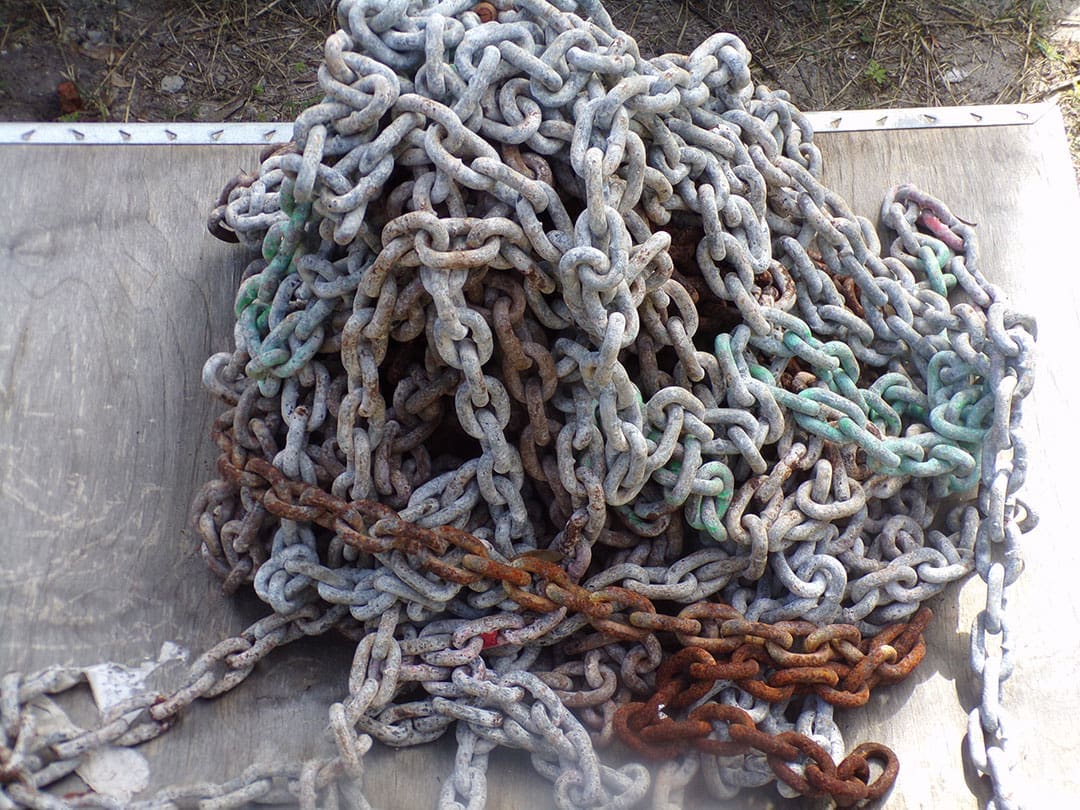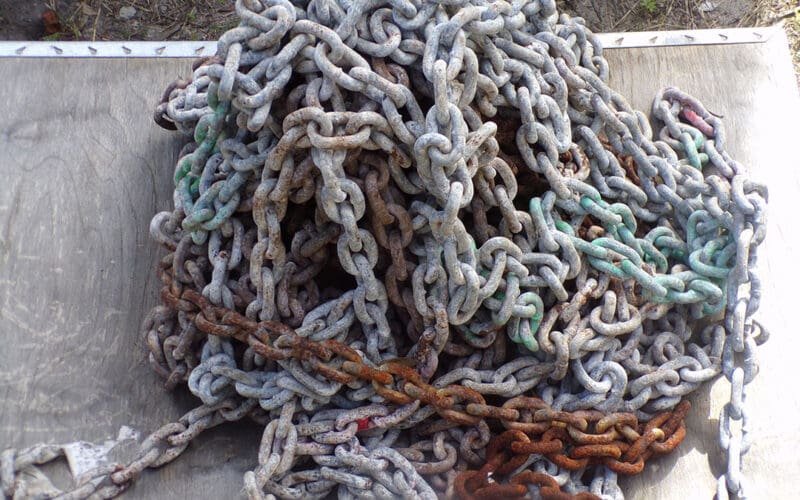
t is the economics of re-galvanizing chain that makes it an attractive alternative to purchasing new chain, as it can cost half as much or less than replacing it with a new length of galvanized links. This is why it is our preferred method for dealing with anchor chain that has reached the point of starting to rust.
Galvanizing performs one function and that is preventing the steel links from rusting. Evidence of rust can range from being so slight that only a surface patina is evident, to the opposite extreme where severe rusting and pitting is present.
However, re-galvanizing chain has two caveats that you should be aware of when undertaking this process. One, if the rust is more than superficial, especially if the chain needs to be sandblasted, then the chain no longer has its published strength and consideration should be given to retiring it from use — you don’t want anchor chain failing when you”re on the hook during a storm.
The second caveat has to do with links that are bent, as they can cause a loss of up to 50 percent of the chain’s strength; with damaged links, the loss of strength can be even greater. Though the chain can still be galvanized, these links need to be removed before returning the chain to service. Any method used to rejoin the sections of chain should be done in a manner that retains the chain’s published strength.
Not all chain can be re-galvanized, however; Grade 30, Grade 43, ACCO’s old designation of “SL”, Australian grades “L” and “M”, metric “Din 766”, and European “EN” can all be re-galvanized, or if purchased “bare”, galvanized to begin with. The chain will come back with a shiny, silvery coating which later will turn a dull gray as it is exposed to the atmosphere or water.
It’s important to note that G7 chain is different; when G7 chain is galvanized it loses approximately 10 percent of its strength. After being galvanized if it is sent back through the heat treatment process a second time it will regain this lost strength. Since this second heat treatment adds additional cost few manufacturers do so unless requested.
If G7 chain is not again heat treated after being galvanized this loss of strength coupled with the “G7” Hallmark, can mislead a mariner into exceeding the chain’s actual strength. To get around this potentially dangerous situation, some companies, ACCO/Peerless Chain Company for one, stamps G7 chain destined to be galvanized with a G6 Hallmark, therefore identifying the chain as having a Work Load Limit (WLL) greater than that of G4, but less than that of G7.
There are several methods used for galvanizing – cold galvanizing, flame sprayed, and hot dipped. Cold galvanizing is done with painted or sprayed-on zinc, but has a very limited service life, especially in a saltwater environment. With flame spraying there is a risk that some areas of the chain will be inadequately covered.

This leaves hot-dipped galvanizing (HDG), the method of choice for galvanizing chain, with double-dipping an even better choice. Double-dipping is nothing more than keeping the chain in the molten zinc for a longer period of time, resulting in a thicker layer of zinc being deposited, thus providing a longer service life. Just about all galvanizing plants will double-dip if requested.
Once the chain is removed from the molten zinc the facility needs to be able to shake or spin the chain to remove as much excess zinc as possible. If the facility is unable to do this it is best to choose another company that can.
Even if the chain was “cleared” of excess zinc, some links may still remain stuck together. You can lay stuck-together links on something hard and strike them with a hammer, breaking them loose. Though a lighter hammer will work, it will require more strikes, thus increasing the risk of damage to the galvanizing; therefore, the heavier the hammer the better. For this job, we prefer a four-pound, short-handle sledge, even if we have to cut a long handle down to about an 18-inch length.
For items that have holes, the holes can remain filled with galvanizing and will need to be drilled out. If bare metal is exposed, which is often unavoidable, you can coat the bare metal with a sticky, rust-inhibiting product, our favorites being: anhydrous lanolin, LanoCote, or Tef-Gel, but petroleum jelly, or a petroleum or synthetic grease can also be used; all require periodic recoating. We also use any of these same products to coat shackle and turnbuckle threads to prevent corrosion, or with stainless steel, galling.
Grinders and files may be required to remove large accumulations of galvanizing in areas that are conducive to their use. Here, too, if bare metal is exposed, one of those sticky, rust-inhibiting products should be applied.
Galvanizing facilities charge by the pound, and though they will accept any size load they usually have a minimum fee. In 2023 this minimum fee was roughly around $400. To meet this minimum fee you can combine your load with someone else who has items that need to be galvanized, or piggy-back your load onto that of a manufacturer who will be taking their product to be galvanized, things like chain, anchors, parts for boat lifts, or trailers parts.
As far as transporting chain or other items to a galvanizing plant, and then getting it back again, individuals can do so themselves. If you’re shipping the chain any distance, dealing with too much weight, or simply do not have the time or inclination to do it yourself, a trucking company can be a practical alternative.n
Rudy and Jill Sechez, authors of Anchoring-A Ground Tackler’s Apprentice (book, e-book, app) have been living aboard, and cruising since 1997, first aboard a 37 foot, wood cutter they built, now aboard Briney Bug, a 34-foot, sail-assisted, wooden trawler that they designed and built. For more information on anchoring and cruising, see their website trawlertrainingabc.com.

